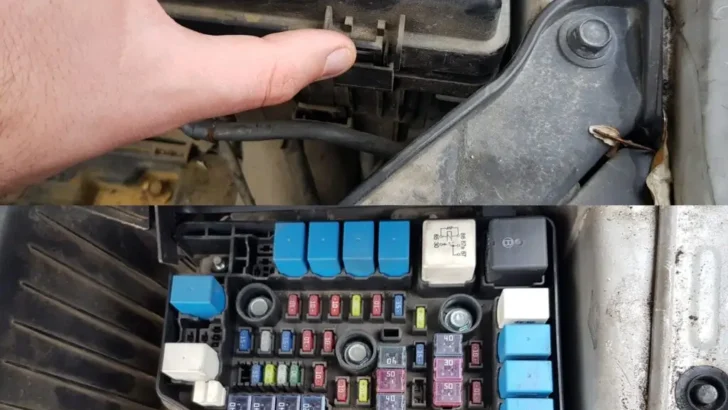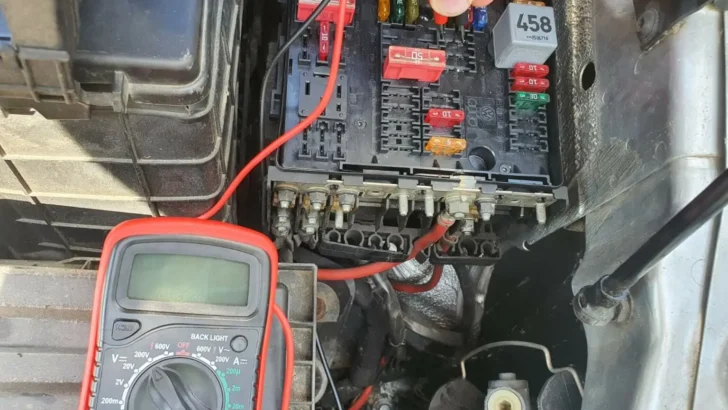If your car isn’t starting, one of the first things you should troubleshoot is the electric fuel pump. This component is responsible for delivering gasoline from the tank to the engine, and if it’s not working properly, your car won’t run.
In this step-by-step guide, I will show you how to troubleshoot an electric fuel pump. We’ll cover everything from checking the fuse to testing the pump itself. So, whether you’re a seasoned mechanic or just a DIY enthusiast, this guide is for you!
Key Takeaway
- The Fuel Pump Voltage Drop Test is a diagnostic procedure that measures the voltage drop across the electrical contacts of the fuel pump to determine if there’s excessive resistance that could be hindering the pump’s performance.
- In order to troubleshoot an electric fuel pump, first, you need to check the fuel pump fuse. This can be done by doing a visual inspection of the fuse itself and testing the fuse holder by using a multimeter. Next, locate the fuel pump and test the power terminal by using a multimeter.
What Is The Fuel Pump Voltage Drop Test
One of the most important tests when diagnosing a fuel pump circuit is the fuel pump voltage drop test. Electrical issues can cause fuel delivery problems and create the wrong impression that the fuel pump is bad when it isn’t. Testing the power and ground circuits to the fuel pump is critical to an accurate diagnosis.
When electrical connections fail, the voltage to the fuel pump is reduced and the fuel pump doesn’t run efficiently. This produces low pressure and possibly noise accompanied by poor performance and even premature fuel pump failure.
Fuel pump voltage drop test checks for voltage lost along a wire through a connection, through a resistance, or any high resistance problem in a circuit. All you need to do the voltage drop test is a digital voltmeter.
By definition, a voltage drop is the loss of voltage caused by the flow of current through a resistance. The increase in resistance in the circuit will create an increase in voltage drop.
One of the most important things during the voltage drop test is the fuel pump must be running. A common mistake when doing a voltage drop test is not to have the fuel pump running because the reading would be inaccurate.
When performing a voltage drop test on a fuel pump, you are looking for typical voltage drops on both the power and ground circuits. The reading shouldn’t exceed 0.5 volts. Anything greater than half a volt suggests electrical issues with the fuel pump circuit.
How Do You Troubleshoot an Electric Fuel Pump

- Check the fuel pump fuse and make sure that is not blown.
- Test the fuse holder for power with a voltmeter.
- Test the fuel pump power terminal with a voltmeter.
- Check the inertia switch
If your car is sputtering or not starting, the electric fuel pump may be the culprit. Many people have this same problem. In this step-by-step guide, I will explain how to troubleshoot your electric fuel pump. Here is how to do it:
1. Check the fuel pump fuse

The first thing that you need to do when troubleshooting an electric fuel pump is to check the fuse. A blown fuse can cause the fuel pump to malfunction. You might think that your fuel pump needs replacing, when in fact, a blown fuse could be the issue.
Open the hood and locate the fuse box. In most vehicles, the fuse box is located on the right side of the engine, right behind the car battery. To open the fuse box, you will need to press down on the clip that holds the plastic cover in place.
Grab your owner’s manual and go to the page about fuses. You will need to know exactly which fuse is for the fuel pump and this information you will get in the owner’s manual. Once you locate the fuel pump fuse, pull it out using pliers or with your hand.

To check if a fuse is blown, look for the metal wire in the middle of the fuse itself. The metal should be continuous from one fuse leg to another. If the metal is continuous then the fuse is alright. However, if the metal is broken, you will need to replace your fuel pump fuse.
2. Test the fuse holder for power

The next thing that you want to do is test the fuse holder and see if it’s getting power. If the fuse holder is not getting power from the battery, it will not be able to provide power to the fuel pump. In order to check the fuse holder for power, you need to remove the fuel pump fuse.
With the fuel pump fuse removed, stick one prong of the multi-meter into one side of the fuse holder, and another prong into the other side. You should be getting a reading of about 12 volts. If you are getting a reading that is below 10 volts, the fuse box isn’t getting enough power.
The reason for that could be damaged wiring from the battery to the fuse box. However, if you get 12 volts on this reading, move on to the next step.
3. Test the fuel pump power terminal

If your vehicle has passed the first two tests, it means that the fuse is alright and that the fuse box is getting power. Now, you will need to check if the fuel pump is getting electrical power all the way back. For this, you will need to locate the fuel pump power terminal.
Usually, the fuel pump power terminal is located by the gas tank. There should be a wiring harness that runs to the fuel pump. This wiring harness is where the fuel pump is getting its power.
Now, on some vehicles is very easy to locate the fuel pump power terminal. On my 2001 Mustang, you don’t even need to remove anything because you can gain access to the fuel pump power terminal just by reaching under the rear bumper.
However, on some vehicles, you might need to remove the metal plate that protects the fuel tank. Regardless, check your owner’s manual and gain access to the fuel pump wiring harness.
Disconnect the wires that supply the fuel pump with electrical power and test them with a multimeter. Since the fuel pump only gets power when the car is in the run position, turn the key into the run position. Do not start the vehicle, just turn the key into the run position and the fuel pump will have electrical power.
Grab the black lead from your multimeter and ground it. With the red lead from the multimeter, check each prong in the fuel pump power terminal connector.
The reading of each prong should be around twelve volts. Be advised that not all prongs will get a twelve-volt reading. But, you should be alarmed only if the prongs are getting 0 volts reading. That means that the fuel pump is not getting electrical power .
4. Check the inertia switch

The purpose of an inertia switch is to cut off the fuel supply to the engine in the event of a collision. This is done to prevent fuel from leaking out and causing a fire.
The switch is usually located in the trunk or under the seat, and it is triggered by the force of the impact. When the switch is triggered, it cuts off the power to the fuel pump, which stops the flow of gasoline.
Inertia switches can be a lifesaver in the event of a serious accident. They are designed to protect you and your vehicle from fires caused by leaking gasoline.
But, in some cases, it can be activated when you hit a bad pothole. So, check your owner’s manual and locate the inertia switch. If it’s in the off position, this will disable the fuel pump and prevent the engine from starting.
Simply flip the switch back to the ”on” position and try to start your vehicle.
FAQs
Q: What is an electric fuel pump?
A: An electric fuel pump is a device that delivers fuel to the engine in a fuel injection system. It is typically located inside the fuel tank.
Q: How does an electric fuel pump work?
A: An electric fuel pump operates by using an electric motor to pressurize the fuel and send it to the engine. It usually includes a fuel filter to remove any impurities before the fuel reaches the engine.
Q: What are the signs of a failing electric fuel pump?
A: Some common signs of a failing electric fuel pump include engine misfires, difficulty starting the engine, frequent stalling, and a loss of power while driving.
Q: How do I diagnose a problem with an electric fuel pump?
A: To diagnose a problem with an electric fuel pump, you can perform a fuel pressure test using a fuel pressure gauge. This will help you determine if the fuel pump is delivering enough pressure to the engine.
Q: Can I replace an electric fuel pump myself?
A: While it is possible to replace an electric fuel pump yourself, it is recommended to have it done by a professional, as it can be a complex and potentially dangerous task.
Q: How much does it cost to replace an electric fuel pump?
A: The cost of replacing an electric fuel pump can vary depending on the make and model of your vehicle, as well as the labor rates in your area. On average, it can cost anywhere from $500 to $1000.
Q: How long does an electric fuel pump last?
A: The lifespan of an electric fuel pump can vary depending on various factors such as driving conditions, fuel quality, and maintenance. Generally, they can last anywhere from 100,000 to 150,000 miles.
Q: Can a clogged fuel filter cause problems with an electric fuel pump?
A: Yes, a clogged fuel filter can restrict the flow of fuel and put additional strain on the electric fuel pump. This can cause the fuel pump to overheat and fail prematurely.
Q: What should I do if my electric fuel pump fails?
A: If your electric fuel pump fails, it is important to have it replaced as soon as possible. Continuing to drive with a faulty fuel pump can result in engine damage and costly repairs.
Q: How often should I replace the fuel filter in conjunction with the electric fuel pump?
A: It is recommended to replace the fuel filter every 30,000 to 50,000 miles or as specified by the manufacturer. Regularly replacing the fuel filter can help maintain the performance of the electric fuel pump.
In Conclusion
Troubleshooting an electric fuel pump is a relatively simple process. With the right tools and approach, it’s possible to identify any problems and resolve them quickly.
By understanding the system components and following basic troubleshooting steps, you can quickly get your fuel pump functioning as expected once again.
